#Molokai Hunting
Explore tagged Tumblr posts
Text
Upland Hunting Hawaii's Moloka'i Island: The Journey Within - A Bird Hunter's Diary | Mark Peterson
Check out the Upland Slam Book its for Sale now: Mark Peterson and his father Earl, … source

View On WordPress
#Bass Pro Shops#Bid Hunting#Big Island Hunting#bird dog#Bird Hunting Hawaii#Black Francolin#Cabelas#Grey Francolin#Grey Frankolin#Hawaii#hunting#Hunting Hawaii#Hunting Molokai#Mark Peterson#molokai#Molokai Hunting#shotgun#Signature Outdoor Adventures#Tags#The Journey Within#upland bird hunting#upland hunting#Upland Hunting Hawaii#Worldwide Trophy Adventure#worldwide trophy adventures#wta
2 notes
·
View notes
Text

This week’s astrology forecast: March 25th to 31st
We are still vacationing on Molokai for our 50th anniversary, so we will let the pics share the story this week.
Message for the week:
The Full Moon Lunar Eclipse in Libra is Monday, initiating the eclipse season with a Total Solar Eclipse in two weeks. Eclipses are the perfect time to shed something that is no longer supporting your essence—let it be eclipsed.
Monday: Full Moon Lunar Eclipse in Libra today at 12:00 AM PDT. This Full Moon is the time to reflect on the balance between self (Aries Sun) and others (Libra Moon)—can you be in cooperative relationships without sacrificing yourself? The Eclipse is the time to let something go that is no longer serving you.
Tuesday: A good day for cooperative endeavors with the Moon in relationship-oriented Libra. Libra’s famed diplomacy may be called on this afternoon while the Moon is opposite Mercury, and you are certain to run across opposing views—aim for win-win negotiations.
Wednesday: Passions run strong today with the Moon entering intense Scorpio in a disruptive square to volcanic Pluto to start the day. The Moon then moves into a flowing trine to courageous Mars—still intense but not combative.
Thursday: This is a great day for dating and romance with Venus (love) in a stimulating sextile to electrifying Uranus. The Moon is in financially shrewd Scorpio, and aspected by Saturn and Jupiter, makes for a good day for business and financial dealings. The night is for love when the Moon is stimulated by Uranus and Venus.
Friday: Expect a quiet and peaceful morning with the Moon in introspective Scorpio to start the day and trine meditative Neptune. The energy picks up this afternoon when The Moon enters high spirited Sagittarius and sextiles transformative Pluto—good humor paves the way for a playful weekend.
Saturday: The Moon is in adventuristic Sagittarius in a supportive trine to the Sun in Aries and is great for getting out and exploring. You may have to deal with a pressing responsibility this afternoon while the Moon squares pressure-laden Saturn—deal with it and get back to play.
Sunday: Happy Easter! The Moon is in Sagittarius—make the egg hunt an adventure, but not so difficult as to make the little ones sad, with the Moon square to the Venus/Neptune conjunction in Pisces. The Moon is in harmony with Mercury, enhancing communications with its upbeat vibe. The Moon enters Capricorn late tonight—clean up time.
May the stars be with you!
Donations: Although these weekly updates are free, if you would like to support the newsletter with a donation, go to my website and click the “Donate” button on the menu. You can donate in increments of $5. You can also donate through Venmo: David-Pond-17 If you would like to send a check, contact us for our mailing address. Thanks for your support!
Consultations: I am available for consultations if you would like to see how your astrology chart can help you connect with your true self, explore your life’s purpose, better understand relationships, find your right vocation, or to align with current astrological influences. Contact us by email, phone, or through the “Services” tab on our website, to set up a session.
Email: [email protected]
Website: Davidpond.com
Phone: 360-918-8411
May the stars be with you!
0 notes
Video
The Best Foam Roller The Morph With Collapsible Core Technology 2021 #sh...
MORPH FOAM ROLLER
https://lite.bz/CCy3z This collapsible foam
roller helps you tackle muscle recovery
https://lite.bz/sbEqe This collapsible foam
roller helps you tackle muscle recovery
1 note
·
View note
Photo

Went out with the guys early this morning to hunt for deer 🦌. While on the trail something happened to the truck and we had to turn around. Hopefully it can be fixed and we can go back out tomorrow morning. We went back to the house and our friend @fish_mann Dedric made us breakfast 🍳 and we got to taste his delicious venison steaks! Thank you Dedric and Jers for your hospitality and the yummy breakfast! #molokai #venison and #eggs #deer #hunting #earlymorning https://www.instagram.com/p/CDXeVEDBiSz/?igshid=h635vh69nrgk
0 notes
Text
“‘Researchers have identified a pattern in the molestation crisis afflicting the Roman Catholic Church: most of the victims are older boys.’
So begins an article by Rachel Zoll from March of last year. Hardly a surprising finding, you might think, but that’s because you’re not in the sex-abuse industry. The Vatican’s recent symposium on child abuse delivered the ‘state of the art information’ that—wait for it—‘the majority of cases in the American crisis involve adolescent males victimized by adult gay priests.’ And the concern we should have as a consequence of these discoveries is increased protection for vulnerable boys, right? Wrong again. ‘“What I’m afraid of is we’re going into this witch hunt for gays,” said the Rev. Stephen Rossetti, psychologist and sex abuse consultant to the United States Conference of Catholic Bishops.’
Rossetti, the former CEO of the St. Luke Institute, is the author of the article mentioned below in support of ‘reintegrating pedophiles.’ He was invited to address the bishops in Dallas this year, and had a ringside seat at the Vatican symposium in question. Surprised? Neither am I.” [4/7/03]
“Perhaps [child molesters’] presence in society can ultimately be healing for us. They challenge us to face an unconscious and primal darkness within humankind. Our inability to face this darkness causes us to stereotype and banish all who embody our estranged dis-passions. In the past, this process spawned Molokai and a host of other human prisons. Today, we are banishing the child molester.
From ‘The Mark of Cain: Reintegrating Pedophiles’, America, September 9, 1995. The Rev. Stephen Rossetti of the St. Luke Institute is one of the three or four experts who have taught the U.S. bishops most about child abuse.” [4/11/03]
— Paul Mankowski, SJ, in Diogenes Unveiled
3 notes
·
View notes
Photo

Deck mates @jordan_hailimila & @javiercantellops handling their share of the action from yesterday's journey 🙌🍀👊 • • Freedive Hawaii offers World Class Freediving Instruction & Guided Offshore Spearfishing Trips 7 days/week 🙌 Click ⬆️⬆️⬆️link in bio⬆️⬆️⬆️and dive in to a world of adventure today! • • #freedive #freediving #freedivehi #maui #hawaii #molokai #lanai #adventure #paradise #pescasub #apnea #mahi #ahi #ono #wahoo #bluewater #spearfishing #divedeep #ocean #hunting #oraganic #farmtotable #nogmo #fucktrump #susutainable #harvest #onelove #onebreath #oneaina #aloha 📸 @freedivehi (at Freedive Hawaii)
#hawaii#nogmo#farmtotable#lanai#freedive#adventure#hunting#bluewater#harvest#ocean#oraganic#ono#pescasub#freediving#molokai#onebreath#divedeep#spearfishing#paradise#wahoo#freedivehi#oneaina#apnea#onelove#maui#mahi#susutainable#fucktrump#ahi#aloha
1 note
·
View note
Text
Masters List of States
Regions
West
Alfred Frederick Rogers-Jones
19
--
MidWest
Jackson Finnick Wright-Jones
18
--
North
Jeffery Kustaa Smith-Jones
21
--
South
Kenneth Eirik Thomas-Jones
21
--
SouthWest
Jasmin (Jazz)
18
------------------
Dead Republics/Territories
Republic of Texas
Austin Lorenzo Bipin Martinez-Jones
17
--
Spanish Florida
Domingo Felipe Chitto Rodriguez-Jones
17
--
Puerto Rico
Luis Alonso Rivera-Jones
17
--
Republic of Vermont
Mary Lawrence Brooks-Jones
17
--
Republic of California
Francisco Matthew Henadez-Jones
16
--
Kingdom Hawai’i
Kalani Kameāloha
17
--
Russian Alaska
Kenojuak Hunt-Jones
17
--
Louisiana Territory
Antoinette Cathrine Zonta LeBlanc-Jones
17
--
States
--
North Delaware
Elizabeth
December 7 (15)
--
South Delaware
Mark
December 7 (15)
--
Pennsylvania
Klaus
December 12 (15)
--
New Jersey
Jason
December 18 (15)
--
Georgia
Noah
January 2 (15)
--
Connecticut
Lene
January 9 (15)
--
Massachusetts
Madison
February 6 (15)
--
Maryland
Grace
April 28 (15)
--
South Carolina
Samantha Caroline
May 23 (15)
--
New Hampshire
Florence
June 21 (15)
--
Virginia
Violet
June 25 (15)
--
New York
Leonardo
July 26 (15)
--
North Carolina
Natalie Coraline
November 21 (14)
--
Rhode Island
Anthony
May 29 (14)
--
Vermont
Mabel
March 4 (14)
--
Kentucky
Joseph
June 1 (14)
--
Tennessee
Travis
June 1 (14)
--
Ohio
Rose
March 1 (14)
--
Louisiana
Lillian
April 30 (14)
--
Indiana
Isabella
December 11 (14)
--
Mississippi
Olivia
December 10 (14)
--
Illinois
Chloe
December 3 (13)
--
Alabama
Marcel
December 14 (13)
--
Maine
Melisa
March 15 (13)
--
Missouri
Madison
August 10, (13)
--
Arkansas
Andrew
June 15 (12)
--
Michigan
Conner
January 26(12)
--
Florida
Nickolas
March 3 (11)
--
West Texas
David Jones
December 29, (11)
--
East Texas
Sage
December 29, (11)
--
North Texas
Elijah
December 29, (11)
--
South Texas
??
December 29, (11)
--
Iowa (i-o-wa)
Taylor
December 28 (11)
--
Wisconsin
Matteo
May 29 (11)
--
South California
Xavier
September 9 (10)
--
North California
Layla
September 9 (9)
--
Minnesota
Eleanora
(May 11 (10)
--
Oregon
Clementine
February 14 (10)
--
Kansas
Nathan
January 29 (10)
--
West Virginia
Wilson
June 20 (10)
--
Nevada
Dean
October 31 (10)
--
Nebraska
Edward
March 1 (10)
--
Colorado
Alec
August 1 (10)
--
North Dakota
Oscar
November 2 (9)
--
South Dakota
Oliver
November 2 (9)
--
Montana
Claire
November 8 (9)
--
Washington
Owen
November 11 (9)
--
Idaho
Madelyn
July 3 (9)
--
Wyoming
Simeon
July 10 (9)
--
Utah
Paige
January 4 (9)
--
Oklahoma
???
November 16, (8)
--
New Mexico
???
January 6, (8)
--
Arizona
Alejandro
February 14, (8)
--
East Alaska
Kaltag
January 3, (7)
--
West Alaska
Anastasia
January 3 (6)
--
Hawaii
Leimomi
August 21,(6)
--
Maui
Kaimana
August 21,(6)
--
Kahoolawe
Koa
August 21,(6)
--
Oahu
Malie
August 21,(6)
--
Molokai
Alani
August 21,(6)
--
Kauai
Lani
August 21,(6)
--
Lanai
Maoni
August 21,(6)
--
Niihau
Akela
August 21,(6)
--
Puerto Rico
Alondra
(10)
--
Micronations
--
Fredonia
Frederick Martinez-Jones
13
--
Talossa
Melody Jones
(1979) 7
--
Conch Republic
Sam
(1982) 7
--
North Dumpling
Danella
(1986) 7
--
Freedonia
Anthony
(1997) 6
--
Molossia
Micheal Jones
(1999) 14 - Nevada
--
Global Country of World Peace
Daisy Peace Jones
(2000) 4
--
Zaqistan
Zach Jones
(2005) 2
--
British West Florida
Fiona
(2005) 2 - Florida
13 notes
·
View notes
Text
Branta
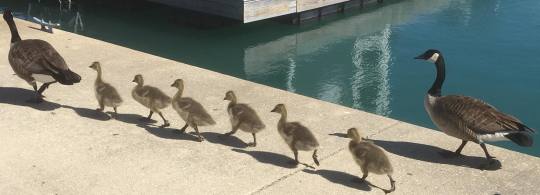
Canada Geese family, by Me!
PLEASE SUPPORT US ON PATREON. EACH and EVERY DONATION helps to keep this blog running! Any amount, even ONE DOLLAR is APPRECIATED! IF YOU ENJOY THIS CONTENT, please CONSIDER DONATING!
Name: Branta
Status: Extant
First Described: 1769
Described By: Scopoli
Classification: Dinosauria, Saurischia, Eusaurischia, Theropoda, Neotheropoda, Averostra, Tetanurae, Orionides, Avetheropoda, Coelurosauria, Tyrannoraptora, Maniraptoriformes, Maniraptora, Pennaraptora, Paraves, Eumaniraptora, Averaptora, Avialae, Euavialae, Avebrevicauda, Pygostylia, Ornithothoraces, Euornithes, Ornithuromorpha, Ornithurae, Neornithes, Neognathae, Galloanserae, Anseriformes, Anseres, Anatoidea, Anatidae, Anserinae
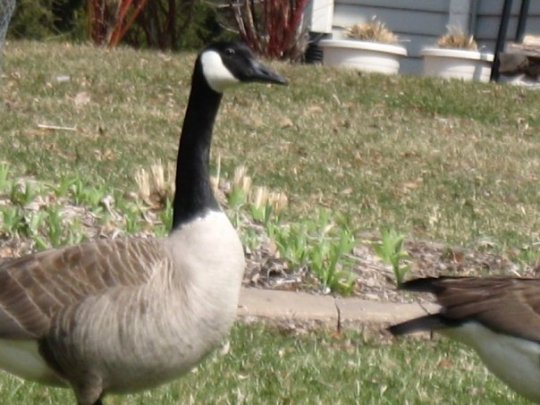
Canada Goose by Me
Referred Species: B. bernicla (Brant Goose, extant), B. ruficollis (Red-Breasted Goose, extant), B. sandvicensis (Nēnē, extant), B. hylobadistes (Nēnē-Nui, extinct), B. rhuax (Giant Hawai’i Goose, extinct), B. canadensis (Canada Goose, extant), B. leucopsis (Barnacle Goose, extant), B. hutchinsii (Cackling Goose, extant), B. woolfendeni (extinct), B. thessaliensis (extinct), B. dickeyi (extinct), B. esmeralda (extinct), B. howardae (extinct), B. propinqua (extinct), B. hypsibata (extinct)

Read-Breasted Goose by Tony Hisgett, CC BY 2.0
Our last entry in this triple-whammy punch of large genera - Branta, the black geese! These include geese from the northern regions of North America and Europe, extending into more temperate regions of North America as well. Being called Black Geese, most have black coloration on their bodies, usually the neck, though the Red-Breasted Goose is also black for most of its body. Their legs and feet are also black or at least very dark grey, which sets them apart from other geese - in addition to being usually smaller, though some are quite large. Those found in Europe are more coastal than the geese of the genus Anser, though those found in North America are found throughout the continent.

Nēnē by Francis C. Franklin, CC BY-SA 4.0
The first specimens of Branta are reported from about 15.97 million years ago, in the Langhian of the Miocene, though these are fairly suspect and its probable that Branta did not appear until later in the Miocene. They probably first appeared in North America, though that is under some debate. B. woolfendeni is known from the Late Miocene of Arizona and one of the earliest known species. B. thessaliensis is known from the Late Miocene of Greece, indicating this bird diversified rapidly if it is from North America. B. thessaliensis also indicates that Branta lived across climate zones prior to the Ice Age, and is only restricted to its current range due to adaptations through the Ice Age. B. thessaliensis is also, interestingly, about the size of the living Canada Goose. B. dickeyi is known form the Pliocene of the Western United States, and B. esmeralda is known from the Early Pliocene of Europe, as is B. howardae. B. propinqua and B. hypsibata are both known from the Pleistocene of Fossil Lake in the United States.

Bernache Goose by Ludovic Péron, CC BY-SA 3.0
Hawai’i back in the day sported two very distinct geese, the Giant Hawai’i Goose and the Nēnē-Nui. The Giant Hawai’i Goose, B. rhuax, lived in the earliest portions of the Holocene, and it is the first fossil bird to be described from Hawai’i. The bones of the bird are rather warped due to lava flow, though it appears to be bigger than other Hawaiian geese and might be as large as the living Cape Barren Goose of Australia, which weighs up to 7 kilograms, though its difficult to tell due to the warped bones. The Nēnē-Nui, or B.hylobadistes, also lived in the Holocene of Hawai’i, specifically Maui, Kaua’i, O’ahu, and possibly Moloka’i. Many subfossils are known of this bird, which indicate it was similar to the living Nēnē. It was evolving towards flightlessness, with most fossil individuals show diminished flight capability at best, with some showcasing flightless individuals with diminished wings. This is one of the few fossil species showing the evolution of the process of flightlessness, rather than the end result. They weren’t completely reproductively isolated from the Nēnē, which was slowing down this process. They went extinct soon after human arrival on the islands.
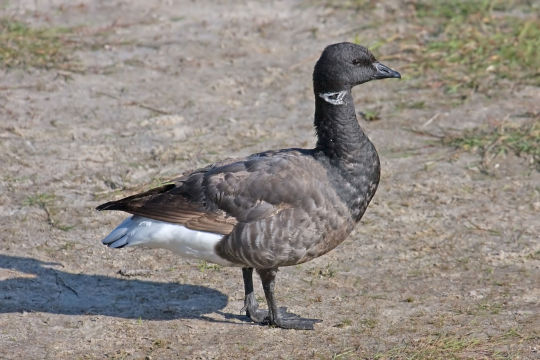
Brant Goose by Andreas Trepte, CC BY-SA 2.5
The earliest derived living species of Branta is the Brant Goose, a rather small goose with a short and stubby bill and darker, less characteristic plumage than other species in this genus. There are three subspecies, all separated by their particular brand of coloration. These birds spend the summer in Arctic coastal regions of North America and Eurasia, then wintering in more southern portions of these continents and even in Northern Africa. There are permanent populations of these geese, most notably in the United Kingdom, Pacific Coast of the United States, and New England. They weigh up to 2.2 kilograms, making them very small geese indeed.
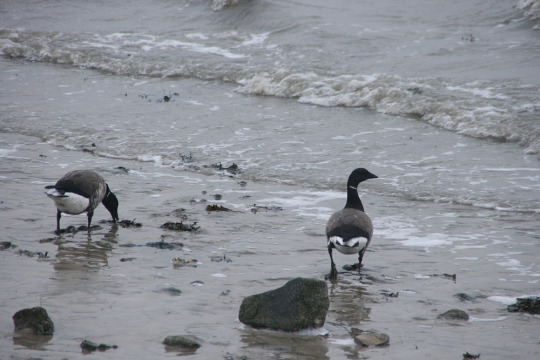
Brant Geese by Henrike Mühlichen, CC BY-SA 3.0
These geese are mostly coastal birds, primarily found in tidal estuaries where it feeds on various sea plants such as seaweed, sea lettuce, and eel-grass. However, some have moved more inland, feeding on agricultural products such as cereals and grass, potentially copying other geese in doing so. They are considered to be not threatened with extinction, though some North American populations have been badly hit in the past.
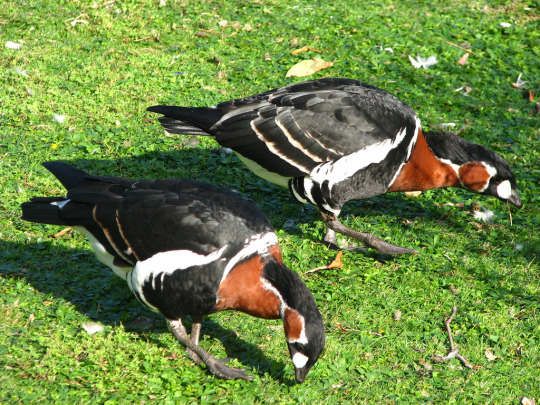
Red-Breasted Goose by Iorentey, CC BY 2.0
Even more visually distinct from other members of the genus than the Brant Goose, the Red-Breasted Goose is seemingly a visual outlier - with red feathers on its neck and chest and black and white feathers all over its body, it looks like it should be a completely different type of goose. And yet, it is not. B. ruficollis is known primarily from Eurasia, breeding in Siberia and migrating down to Eastern Europe and Central Asia during the winter. These birds are vulnerable to extinction, due to limited sites utilized during the breeding season, sites that are threatened due to human land use. Conservation efforts are ongoing in attempts to preserve the species.

Red-Breasted Goose by Dick Daniels, CC BY-SA 3.0
The Red-Breasted Goose usually weighs only about 1.5 kilograms, making it a very small bird indeed. It makes a shrill and staccato call, and despite its small size it actually prefers to nest alongside birds of prey like owls and falcons, which helps to protect their eggs from mammal predators. The birds of prey protect the geese from predators, and rarely attack them themselves. They have very large nesting colonies, which also contribute to safety in their habitats. They also nest on rivers and islands, but they prefer using birds of prey for protection instead. THeir colonies have usually about 4 pairs, though there can be more if food is abundant, and they rarely leave a 1.5 kilometer radius of the nest. The males guard the young from a distance, while the females roost on the nest. They feed mainly on grasses, leaves, and seeds.
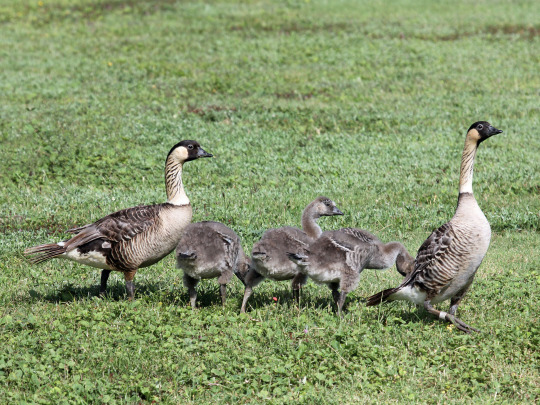
Nēnē by Dick Daniels, CC BY-SA 3.0
The Nēnē is where we finally start inching towards the common color pattern of Branta, though it is browner potentially as an adaptation for a more terrestrial lifestyle. It is a goose endemic to Hawai’i, and is the state bird of Hawai’i! It is found on Oahu, Maui, Kaua’i, Molokai, and Hawai’i itself, in terms of specific islands, and its name comes from its soft call. It is the world’s rarest goose, almost driven extinct due to human activity and introduced mammal predators (thanks, humans). Today, conservation efforts and breeding programs have successfully gotten the population from 30 birds to 2,500 birds, though it’s still considered vulnerable and efforts are heavily ongoing.
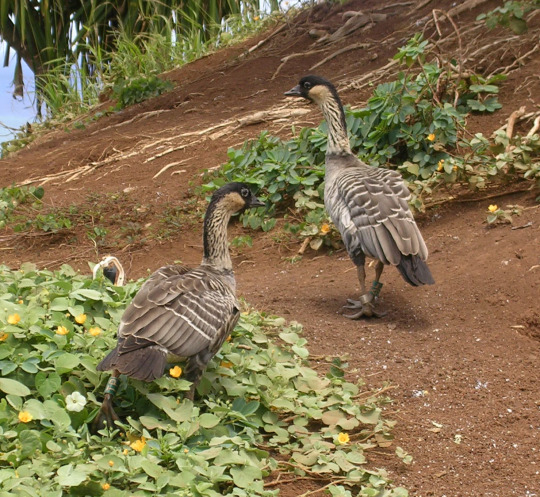
Nēnē by Caracas1830, CC BY-SA 2.5
The Nēnē is about 8.6 kilograms in weight, and it is closely related to the Canada Goose, and may have even evolved from it, though that is under some debate. They spend most of their time on the ground and have very distinctive feet, widely splayed flippers that give them more surface area while walking on the ground. They are capable of flight, however, though they still primarily live inland in shrubland, grassland, dues, and lava plains. They feed on leaves, seeds, fruit, and flowers as well as grass and shrubs. They breed from August to April, so for a long period of time, longer than any other goose species. They nest on land, unlike other waterfowl, and the female lays between one to five eggs and incubates them for about a month, while the male guards. The goslings then stay with their parents until the next breeding season.

Canada Goose by Daniel D’Auria, CC BY-SA 2.0
The Canada Goose, B. canadensis, is arguably the most famous goose - at least to people in America - due to it rather common state. It is native to the arctic and temperate regions of North America, and it does extend into northern Europe, introduced into the United Kingdom, New Zealand, Argentina, Chile, and the Falkland Islands. These birds are very successful in living in urban areas, to the point where I can’t really go anywhere in Chicago (my home) without seeing one. They tend to breed well in park areas, and they beg for food from humans around them, which just kind of exacerbates the problem. Honk.
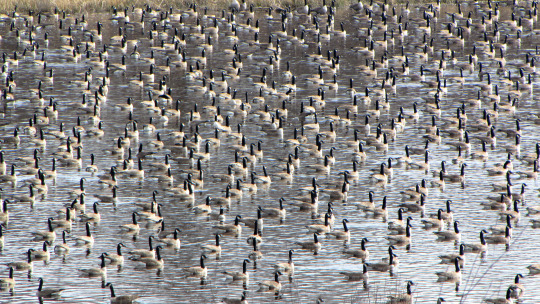
Canada Geese by D. Gordon E. Robertson, CC BY-SA 3.0
Canada Geese were, at one point, threatened with extinction due to over-hunting and human activity (most notably aircraft strikes), but conservation efforts for this bird may be too successful, with between 4 and 5 million birds estimated in North America alone, in the year 2000. Today, culls of geese in densely populated areas occur, but the bird is still protected under environmental laws and is not legal to be hunted most times of the year. I personally don’t ultimately see a problem with this in North America. In Eurasia, their introduction does pose a threat to agricultural and native goose populations, and introduction in New Zealand also threatens agricultural practices, making their presence in these regions a serious problem.
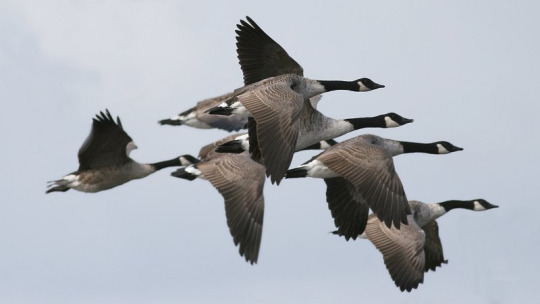
Canada Geese by Ken Billington, CC BY-SA 3.0
These birds weigh up to 10.9 kilograms, though they usually don’t exceed eight kilograms, and have very large wingspans that aid in their long flights and migrations. They have a distinctive white chinstrap on their black heads, and brown feathers throughout the bodies, as well as black legs and necks. Migratory birds, they form V-shaped flying formations while moving across North America during the spring and autumn. They usually spend the summers in Canada, and the winters in Southern United States, with year-round birds found in the Northern United States (so, you know, where I live). (They’re everywhere).
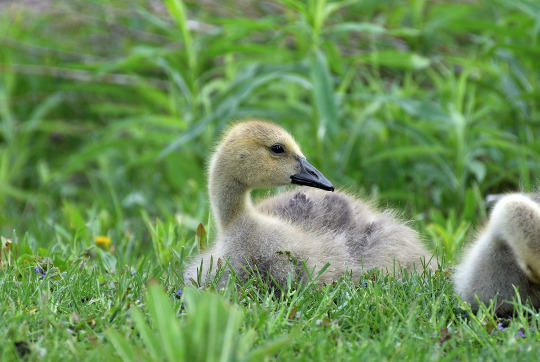
Canada Gosling by Saud, CC BY-SA 4.0
The Goslings are yellow and grey, becoming more grey as they age and then receiving adult plumage when they reach sexual maturity. The geese are monogamous, usually staying with the same mate for their whole lives, unless they are widowed at which point they find a new mate. The female lays two to nine eggs and incubates them, while the male finds food and tends to wander around. They nest near streams, lakes, and ponds for about 28 days. The goslings are immediately capable of walking, swimming, and finding food, with the parents leading the goslings in a line with one adult at the front and the other at the back, and the adults are violently protective of their chicks. Though, speaking from experience, if you’re a small child just reading a book by the pond and a bunch of geese start gathering around you, they probably won’t mind your presence. And might even remember you. So for their lifespan of ten to twenty four years they might just continue to be chill with your presence at the pond by your house. But that’s just my guess. The offspring fledge at about 9 weeks and dont’ leave their parents until they return to their birthplace.

Barnacle Goose by Andreas Trepte, CC BY-SA 2.5
The Barnacle Goose is next on our series of black geese, and it is in fact blacker than the geese we have seen so far, with distinctively dark necks and more monochromatic plumage. They weigh up to about 2.23 kilograms, making them fairly small as far as geese go. They are known primarily from Eurasia, breeding up in Greenland, Scotland, Ireland, Norway, and the Netherlands. Some have managed to migrate to the United States and Canada, but these expansions are rare, and oftentimes a wild Barnacle Goose is just a mistaken escaped one (they are popular waterfowl to collect, apparently).
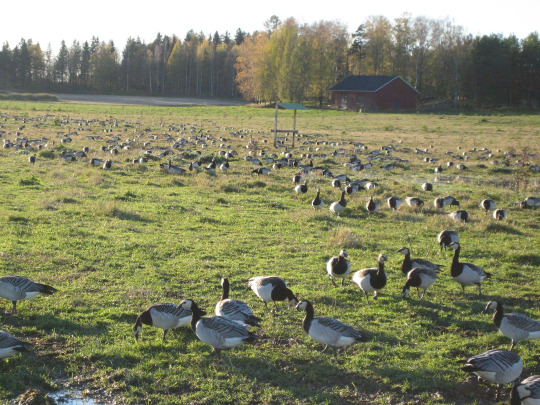
Barnacle Geese by MPorciusCato, CC BY-SA .30
These geese build their nests on high mountain cliffs away from predators and food, and rather than adults bringing food to their goslings, the goslings go out to get their own food! The three-day-old goslings fall off the cliffs and their small size and feathery down help to protect them when they hit the rocks below, but oftentimes they just straight-up die, so that’s... a thing. Arctic foxes then prey on many of them as the adults lead them to wetlands for gathering food. Still, the Barnacle Goose does not appear to be threatened with extinction. Their weird mode of reproduction has lead to many legends being woven about them, such as that they came from driftwood; they are so different from other waterfowl that there’s a separate kosher ruling about them, decreeing that they are, in fact, kosher. But I wouldn’t eat them regardless.
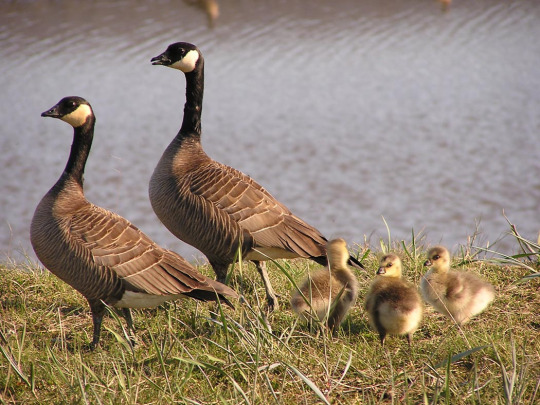
Cackling Goose by Tim Bowman, in the Public Domain
The Cackling Goose is our last member of the genus, and it is essentially indistinguishable from the Canada Goose, with lots of overlapping range. They were made into a full species in 2004, though frustration amongst ornithologists remains because, again, they look the same. Still, they do extend into other locations, notably Russia; and they tend to be smaller than Canada Geese on average, but some can weigh up to 3 kilograms and approach the size of Canada Geese. They nest in shallow depressions near the water, in locations lined with plant material. They mate for life, and they will also parade their goslings, in order to reach plant material. They even can tip forward to feed on aquatic plant material, in a sort of dabbling pose. Sometimes they also eat insects, molluscs, and crustaceans. They do not appear to be threatened with extinction. Still, just to drive home how aggravating these birds are, they are probably most closely related to Barnacle Geese, not Canada Geese. There you have it.

Cackling Goose, by Tim Bowman, in the Public Domain
Sources:
https://en.wikipedia.org/wiki/Branta
http://fossilworks.org/?a=taxonInfo&taxon_no=83426
https://en.wikipedia.org/wiki/Branta_thessaliensis
https://en.wikipedia.org/wiki/Branta_rhuax
https://en.wikipedia.org/wiki/N%C4%93n%C4%93-nui
https://en.wikipedia.org/wiki/Brant_(goose)
http://www.luontoportti.com/suomi/en/linnut/red-breasted-goose
https://en.wikipedia.org/wiki/Red-breasted_goose
https://en.wikipedia.org/wiki/Nene_(bird)
https://en.wikipedia.org/wiki/Canada_goose
https://en.wikipedia.org/wiki/Barnacle_goose
https://en.wikipedia.org/wiki/Cackling_goose
#goose#black geese#branta#dinosaur#duck#bird#birblr#palaeoblr#canada goose#brant goose#barnacle goose#cackling goose#red-breasted goose#nene#nēnē#factfile#dinosaurs#biology#a dinosaur a day#a-dinosaur-a-day#dinosaur of the day#dinosaur-of-the-day#science#nature#branta bernicla#branta leucopsis#branta canadensis#branta hutchinsii#branta ruficollis#branta sandvicensis
75 notes
·
View notes
Text
Types of Whales in Hawaii

Whale watching in Hawaii is one of the top rate activities. Every year thousands of humpback whales migrate to Hawaii from Alaska during winter months, making their stay in Hawaii seasonal. But there are other whales that grace the waters of Hawaii year-round!
Humpback Whales
Maui’s most popular whale residents are the humpback whales. As we mentioned, they are seasonal inhabitants, but they return every year to mate, give-birth and enjoy the warm tropical waters.
Although the humpback whales can be found in Oahu, Big Island, Kauai and outer islands, they are most populated in the Maui Nui Basin which is settled between Maui, Kaho-olawe, Lanai and Molokai, It is fairly shallow and offers reef areas that act as safe nurseries for mother humpback whales giving birth or with their young. Humpback whales are a type of baleen whale, the largest mammals on earth and there are more than a dozen species of them! They are called baleen whales because they have baleen, a fringe like filter in their mouth used to capture small fish and plankton for food! Another characteristic that differentiates baleen whales from toothed whales is a pair of blowholes they have (other types of whales only have a single blowhole). Humpback whales are also known for their large pectoral fins and fluke (or tail) markings that are unique to every humpback whale.
Humpback whales can weigh 30-50 tons—that’s 60,000 to 100,000 lbs! Female humpbacks are actually larger than males, ranging from 49-52ft, whereas adult males are 43-46 ft long, the size of a school bus! Humpback whales live to an average of 50 years, and don’t have many predators, except the Orca (killer whale) that preys on young humpback whales.
Humpback whales engage in many surface behaviors including breaching, spyhopping, pec and tail slapping; these are used to communicate with each other. They also sing beautiful songs, which we can hear when we place a hydrophone into the water! This song is sung solely by male humpback whales, but mom and calf pairs use quiet vocal noise to communicate with each other during migration.
Although the humpback whale population is one-third of its original population, the protections that have been put in place have helped the population begin to recover and we see more baby humpback whales every year! You have an excellent chance of seeing Humpback whales in Hawaii if you visit during the migration months of December through April!
Killer Whales
The humpback whale’s top predator, the majestic Orca or Killer Whale, is rarely seen, but has been spotted around the Hawaii island chain. Although their name calls them whales, Orcas are actually a part of the Delphinidae family, also known as oceanic dolphins. Orcas are found across the globe, but most reside in colder waters of the Antarctic, Norway and Alaska. Transient killer whales find their way to Hawaii, but stay far from shore, living in pods of 20 or more animals and using underwater sounds to communicate with each other. Killer whales are also mammals, ranging between 20-30 feet in length with a distinct black and white color and sharply shaped dorsal fin. Orcas feed on small mammals including other whale calves and can live up to 90 years old! They are known for their fierce hunting and intelligence. Although spotting these whales while visiting Hawaii is rare, keep on the lookout, you never know what you may see!
False Killer Whales
Also known as pseudo-orcas, false killer whales are apex predators, feeding off large pelagic fish and other marine life. Although false killer whales got their name because of their similar skull shape to their flashy name sharing cousins, they are distinctly different, solid black or dark grey in color and smaller in size. These mammals are very social and are known to spend time with other members of the dolphin family. There are three groups of pseudo orcas in Hawaii, but they do not interact with each other: The pelagic population, the Northwestern Hawaiian Islands populations and the Hawaiian Islands insular population that is currently endangered. There are specific locations around the Hawaiian Island chain where these pods spend most of their time. We have observed them several times during our snorkel and whale watching tours in Maui.
Blue Whales
Blue whales are one of the rarest whales to be seen in Hawaii, and most confirmations are not sightings but sound recordings of their songs (their call is the loudest animal sound in the world) around the islands throughout the year. Blue whales are endangered and were targeted by commercial whalers in the 1900’s, there are estimated to be only 10,000- 25,000 globally, which is less than 10% of the population that was present in the early 1900. The blue whale population is steadily growing every year since we have reduced commercial whaling. These whales are so large ( about 80 feet long and up to 300,000 lbs) there are no natural predators to adult blue whales (except humans), giving them long life expectancies of 100 year. One of the coolest facts about blue whales is that their hearts are 5 feet long, their babies are born 26 feet long and gain 200 lbs a day feeding on their mother’s milk.
Although the only recorded sighting of blue whales in Hawaii was in the 1960’s we still keep our eyes opened for these massive blue giants.
Other Whales (and toothed-whales)
Melon-headed whales, Blainville and Cuvier’s Beaked whales, Pygmy Killer whales, Dwarf Sperm whales, Short-finned pilot whales and Sperm whales are also present in Hawaii. Many live offshore so sightings are rare and because they are rare most of us wouldn’t even know how to identify them! They vary in sizes, colors and population, but all need our protection and support.
Respect and research help us protect these amazing whales and dolphins in Hawaii! Every ticket with Ultimate Whale Watch and Snorkel helps us support marine research groups like Whale Trust, Keiki Kohola, Cascadia, SCRIPPS, Hamer, NOAA, UH and many more that spend time gaining information on our whales and dolphins in Hawaii and how our ocean environment affects them. We also work as first responders with NOAA’s whale entanglement response team to respond to whales which may be entangled with fishing line, nets or other hindrances. NOAA’s team has successfully disentangled 97 whales since the 1990s and continues to research, educate and protect Maui’s marine life.
Want to learn how to better support Maui’s marine research? Contact us!
0 notes
Text
music library meme
I was tagged (by proxy :P) by @shimyereh
Rules: we’re snooping on your playlist!! Set your entire music library to shuffle and then report the first ten tracks that pop up! Then tag ten additional victims!
Behold:
Tchaikovsky’s Snowflake Waltz (aka Nutcracker Act 1 finale)
Celtic Woman’s Danny Boy
The christmas special of Cabin Pressure (Molokai)
You Need Feet, which should be experienced to be believed
Midnight from Prokofiev’s Cinderella Ballet (Act 1 finale again)
The Hunt from Tchaikovsky’s Sleeping Beauty (act 2 opener)
Thenardier Waltz from Les Miserables
A radio play of The Blue Carbuncle from the Adventures of Sherlock Holmes
Don Quixote Act 1 coda
The female variation from Grand Pas Classique by Daniel-Francois Auber
6/10 are from ballets. Gee its almost like I teach ballet professionally or something...
Tagging @zeusyimhome @serenity74 @mountedpentiumsfryingcircuits and anyone else who sees this and wants in :)
3 notes
·
View notes
Photo

Camo script hats back in stock. Perfect for hunting goat. (at Molokai)
14 notes
·
View notes
Video
instagram
#Repost @buckchasah_productions ・・・ My brother joe bent this head on a managenent buck... a feww minutes ago! @spencer_arrows - - - #SPENCERARROWS #FACELESSJAKE #archery #hunting #bowhunting #deerhunting #deer #hunt #outdoors #whitetaildeer #whitetail #hunter #deerseason #archerylife #huntingseason #bowhunter #elk #whatgetsyououtdoors #archeryhunting #bowandarrow #elkhunting #bowseason #archeryseason #archer #nature #survival #bigbucks #wildlife #huntinglife (at Molokai Island) https://www.instagram.com/p/Bumkzs2BXzx/?utm_source=ig_tumblr_share&igshid=393lhbtwxu9o
#repost#spencerarrows#facelessjake#archery#hunting#bowhunting#deerhunting#deer#hunt#outdoors#whitetaildeer#whitetail#hunter#deerseason#archerylife#huntingseason#bowhunter#elk#whatgetsyououtdoors#archeryhunting#bowandarrow#elkhunting#bowseason#archeryseason#archer#nature#survival#bigbucks#wildlife#huntinglife
0 notes
Video
Best Waterproof Case Water Proof Bag Mobile Phone Case 2021 #shorts
You can use those links below to purchase:https://lite.al/AQ1Xk
1 note
·
View note
Photo

*Eating from the land* 🦌 Last month we went to Molokai and brought back venison that our friend who hunted. 🦌 We brought up foods that they don’t normally get in Molokai or it’s expensive and we got deer! 🦌 We didn’t have a chance to cook it before so with this Labor Day holiday upon us I thought it would be a good time to cook it. 🦌 I took half, seasoned it and fried it up for my meal prep and the other half I made teriyaki. 🦌 It’ll go on the grill later this evening. 🥰 🦌 Did you know that Venison contains only a third of the amount of fat found in beef, and less calories than chicken? 🦌 Venison is richer in protein than any other red meat, which means that it satiates the appetite really well, keeping you fuller for longer. 🦌 It’s high in protein, which is important for muscle growth and repair, hormone production, brain function and sleep. 🦌 Being wild and grass fed, venison is much leaner than beef, and contains less saturated fat. 🦌 It’s also rich in conjugated linoleic acid, which is thought to support a healthy heart, iron and B vitamins, which help you convert the food you eat into energy, and play a vital role in brain and nervous system function. 🦌 So good for you! Thank you #goodhousekeeping for the info! #molokaimeat #venison #islandlife #blessedtobeablessingworldwide #alohaaworldofwellness https://www.instagram.com/p/CE20KoTBMFc/?igshid=1wkmdjpirp1rf
#goodhousekeeping#molokaimeat#venison#islandlife#blessedtobeablessingworldwide#alohaaworldofwellness
0 notes
Text
2018 Dec – Hawaii Hols: Day 9 - Sat 29 Dec 2018 - Big Island
There was a long queue at the Hertz rental car centre at Kona airport, and it took a while before we were able to speak to an agent about picking up our car much earlier than we had planned. Initial response wasn’t positive: “we have no spare cars available”. He rang the team that dealt with returned vehicles, and they confirmed no Camaros had been returned so far today. He said he would have to go out back and check with his “brothers and sisters”, for which I think he was referring to the other rental companies to see whether he could do a deal with one of them.
We were well chuffed when he returned and confirmed a white Camaro would be brought around in about 10 mins - it was being cleaned and valeted as we spoke. Excellent result.
When we packed our luggage into the boot of the Camaro, we were taken by how well we have organised our luggage. It was a perfect fit in to the Camaro’s boot. The only downside was that we had to make full use of the boot, which meant the top would have to stay up.

Waikolo
We wouldn’t be able to get in to our apartment until 3pm, so we decided to head north to one of our old hunting grounds at Waikolo. That’s where the main hotel chain resorts are, including Hilton and Marriott etc.
We stopped off at our old Starbucks at Queens Marketplace and sat out in the courtyard. It was overcast but beautifully warm. What a place to be!

Whilst there, we had a look around the shops and decided that we would stay for lunch, before heading back south, past the airport, towards our apartment at Kailula Kona.
Vick was very good and enjoyed a health salad. I wasn’t good and enjoyed a massive burrito. I am still not very good at resisting temptation!


On the way to Kailula Kona, we stopped off and took a few photos as a taster to what we could enjoy over the next 5 days or so. Big Island is so different to either Kauai or Molokai, which are both very green islands. Big Island is a volcanic island, and consequently, there are lava flows everywhere, and that defines the scenery.

Kailula Kona
When we reached our apartment in the Kona Bali Kai complex, all we could say to each other was “Wow!”
It was a 2 bed, 2 bathroom ocean front apartment and it was so well equipped. We bumped in to the agent’s assistant who was doing final preparation for our arrival. She was really friendly and wished us a pleasant stay.






What a view! Amazing! We were so looking forward to spending time here. However, we needed to do a bit of shopping, so we popped out to Safeway and stocked up with food.

In the evening we enjoyed cheese and biscuits, and a bottle of wine, sat out on our lanai watching and listening to the waves.

What a fab way to finish the day.
0 notes
Photo

@freedivemaui Handling the Mahieeez 🤙 • • Freedive Hawaii offers Hawaii's Premier Freediving Instruction & Private Guided Spearfishing Trips to some of Maui's Top Deep Reef & Bluewater locations 7 days a week 🙌 • • Visir the Freedive Hawaii website ⬆️⬆️⬆️link in bio⬆️⬆️⬆️ and dive into an ocean of exploration today! • • #freedive #freediving #freedivehi #maui #hawaii #molokai #lanai #adventure #paradise #pescasub #apnea #mahi #ahi #ono #wahoo #bluewater #spearfishing #divedeep #ocean #hunting #oraganic #farmtotable #nogmo #fucktrump #susutainable #harvest #onelove #onebreath #oneaina #aloha 📸 @freedivehi (at Freedive Hawaii)
#freediving#freedive#farmtotable#hawaii#fucktrump#nogmo#pescasub#onebreath#apnea#harvest#oraganic#mahi#ahi#bluewater#spearfishing#aloha#freedivehi#hunting#lanai#ono#ocean#maui#adventure#molokai#divedeep#wahoo#susutainable#onelove#paradise#oneaina
1 note
·
View note